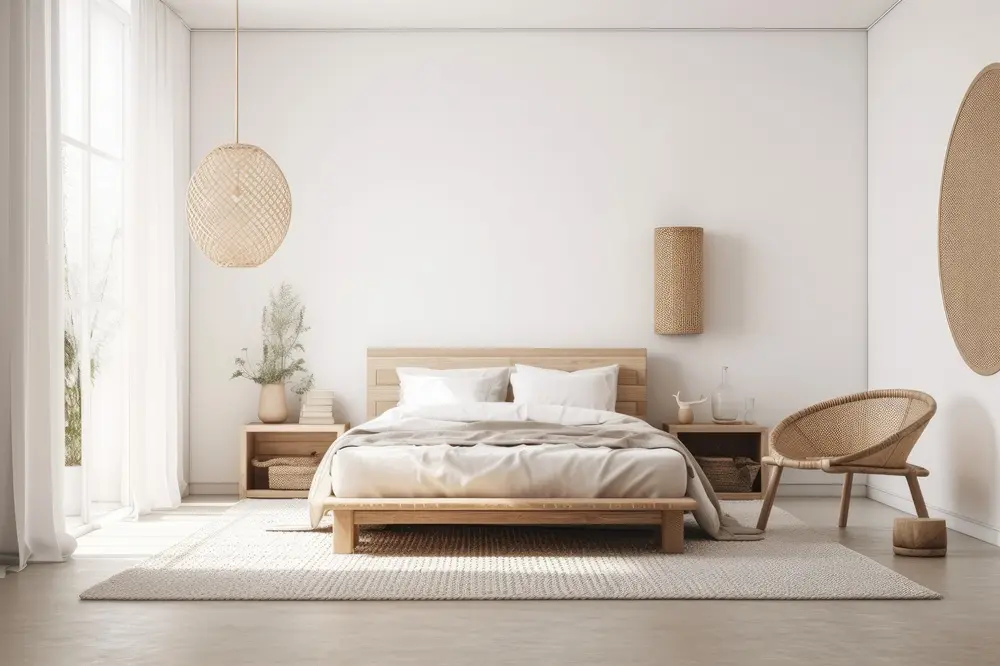Japandi bedroom: Make your bedroom into a comfortable retreat
Many people find it challenging to create a perfect bedroom where you can retreat, rest, and recharge. If you are one of those struggling to rest comfortably in your bedroom, the Japandi bedroom might be a solution. Japandi, a harmonious blend of Japanese minimalism and Scandinavian functionality, offers a serene and cozy environment ideal for rest and relaxation.
We introduced basic elements of Japandi design before but in this guide, we will see how you can create a bedroom that represents the calm and comfort of Japandi design.
1. Decluttering and Simplifying

One of the core principles of Japandi design is the emphasis on simplicity. This begins with decluttering your space. A cluttered room can lead to a cluttered mind, making it difficult to relax and unwind.
Start by removing any unnecessary items from your bedroom, except a few meaningful decoration items that please you but do not overwhelm the space. Create a space that feels open and airy but personal. If you still have things that must stay in the bedroom, invest in functional minimalist design storage that helps keep your room tidy. The clean line furniture keeps surfaces clear and maintains a sense of order.
Keep the bedding minimal and clutter-free. Use high-quality sheets, a cozy duvet, and a few pillows.
2. Neutral Color Palette

The color palette in a Japandi bedroom is typically neutral and muted, creating a calm ambiance. These colors, such as white, grey, and beige, help to promote relaxation and the minimalist appearance. Also, you can incorporate earthy tones such as soft browns and greens. These colors bring a touch of nature into the room.
While the primary colors should remain neutral, you can add subtle accent colors in darker tones through small decorative pieces without drawing too much attention. Black metallic finish items often work well with soft neutral Japandi rooms.
3. Natural Materials

Japandi design emphasizes the use of natural materials. The warmth and texture of wood adds a sense of coziness to the room. Look for a bedframe with clean lines and simple designs that reflects the minimalist aesthetic. Bed covers and rugs also should be of natural fibers. It is not difficult to find ones that are made from cotton, linen, or wool. These items are not only comfortable but also free of any synthetic odors, contributing to a better night's sleep.
You can also embrace nature in your bedroom by incorporating a décor styled with earthy elements like stone, bamboo, ratan, and clay. Natural items not only look beautiful but also have a calming effect on the mind.
4. Low Platform Beds

Japandi design does not generally go well with high furniture. Beds should be low and close to the floor. A low platform bed inspires simplicity and elegance and avoids overpowering the space. Choose a low platform bed with a straightforward design. Avoid unnecessary details and opt for clean lines and smooth surfaces.
Ensure that the bed provides adequate support and comfort. A good mattress is essential for a good night's sleep.
5. Japanese-Inspired Beds and Textiles

You may consider a tatami-style bed for an authentic touch. These traditional Japanese sleeping surfaces consist of firm, woven rush grass mats on which a futon mattress is placed.
Japanese-inspired textiles can add a touch of tradition and character to your space. Embrace the wabi-sabi philosophy, which celebrates the beauty of imperfection. Choose textiles that have a handmade quality, such as hand-woven blankets or naturally dyed fabrics.
6. Zen-Inspired Decor

Zen philosophy is rooted in Japandi design. Incorporating Zen-inspired decor can help create a peaceful environment in your bedroom. When you are designing the bedroom, think of a serene and peaceful space suitable for mindful practices such as meditation, deep breathing, or gentle stretching.
For wall decoration, choose minimalist art pieces that evoke a sense of calm and contemplation. Abstract art, ink paintings, or nature-inspired prints are excellent choices. Keep the frames simple and understated.
7. Modern and Traditional Fusion

Japandi design requires a perfect balance between modern and traditional elements. This fusion creates a unique and harmonious space that is both functional and aesthetically pleasing.
One of the ways to do so is to combine contemporary furniture of Scandinavian design and traditional Japanese decor. Look for furniture with sleek lines, functional designs, and minimalistic features that will balance well with traditional Japanese accents. This could include shoji screens, bonsai plants, or calligraphy art. These elements add depth and cultural richness to the room.
8. Soft Lighting

Lighting plays a crucial role in creating the right ambiance to set the mood for relaxation. Soft, warm lighting can help you rest and prepare for sleep. Ambient lights are effective such as floor and table lamps or headboard lights with warm-toned bulbs. Avoid harsh, bright lights that can disrupt the calming atmosphere.
But during day time, maximize natural light. Use light, sheer curtains that allow sunlight to enter the room while maintaining privacy. Natural light enhances the room's openness and connection to nature.
Conclusion
Creating a Japandi bedroom is about more than just aesthetics; it must provide a perfect environment to promote rest, relaxation, and well-being. Embrace the Japandi philosophy and create a space where you can truly unwind and recharge.
If you want to extend this serene and comfortable ambiance beyond the bedroom to the entire house, consider these resources:
- for the kitchen, refer to this article
- for the living room sofa, explore this guide and
- for home accessories, check out this piece

